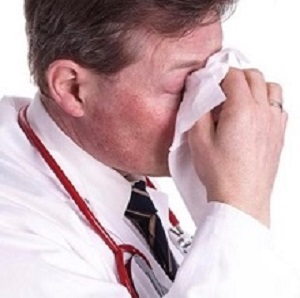 Some four in 10 of healthcare professionals (HCPs) work while experiencing influenza-like illness (ILI), according to the findings of a US survey. As in all workplaces, contagious employees risk infecting others when they turn up for work. But with higher concentrations of older patients and individuals with immuno-suppression or severe chronic diseases in healthcare facilities, ILI transmission by HCPs presents a grave public health hazard.
Some four in 10 of healthcare professionals (HCPs) work while experiencing influenza-like illness (ILI), according to the findings of a US survey. As in all workplaces, contagious employees risk infecting others when they turn up for work. But with higher concentrations of older patients and individuals with immuno-suppression or severe chronic diseases in healthcare facilities, ILI transmission by HCPs presents a grave public health hazard.
“The statistics are alarming. At least one earlier study has shown that patients who are exposed to a healthcare worker who is sick are five times more likely to get a healthcare-associated infection,” said lead researcher Dr Sophia Chiu, the US CDC’s National Institute for Occupational Safety and Health. “We recommend all healthcare facilities take steps to support and encourage their staff to not work while they are sick.”
The annual study, conducted via a national online survey, collected data from 1,914 HCPs during the 2014-2015 influenza season. Respondents self-reported ILI, defined as the combination of a fever and cough or sore throat, and listed factors that prompted them to turn up for work.
The survey assessed a variety of health occupations across multiple institutions: physicians; nurse practitioners and physician assistants; nurses; pharmacists; assistants/aides; other clinical HCP; nonclinical HCPs; and students. Four types of work settings were assessed: hospitals; ambulatory care or physician offices; long-term care facilities; or other clinical settings.
Among the findings:
• Of the 1,914 HCPs surveyed, 414 reported ILI. Of these, 183 – or 41.4% – reported working for a median duration of three days while experiencing influenza-like symptoms.
• Hospital-based HCPs had the highest frequency of working with ILI (49.3%), compared to HCPs at long-term care facilities (28.5%). Clinical professional HCPs were the most likely to work with ILI (44.3%), with pharmacists (67.2%) and physicians (63.2%) among those with the highest frequency.
• In contrast, the survey found that assistants and aides (40.8%), nonclinical HCPs (40.4%), nurse practitioners/physician assistants (37.9%), and other clinical HCPs (32.1%) worked while sick.
• The most common reasons for HCPs to opt from taking sick leave included feeling that s/he could still preform his/her job duties; not feeling “bad enough” to stay home; feeling as if s/he were not contagious; sensing a professional obligation to be present for co-workers; and difficulty finding a co-worker to cover for him/her. Among the HCPs who felt they could still preform their job duties, 39.0% sought medical attention for their ILI symptoms, as did 54.0% of those who did not think they were contagious. 49.8% of HCPs in long-term care settings who reported for work when sick reported doing so because they couldn’t afford to lose the pay.
• Previously published results from this survey described that only 77.3% of respondents reported receiving a flu shot. The US Department of Health and Human Services’ Healthy People 2020 aims to reach a 90% influenza vaccination rate for HCPs.
• HCPs with self-reported ILI missed a median number of two work days. Of this cohort, 57.3% visited a medical provider for symptom relief; 25.2% were told they had influenza.
The Centres for Disease Control and Prevention recommends that anyone with ILI wait 24-hours after a fever breaks before returning to work.
“Patients’ health and wellbeing are at stake when contagious HCPs opt not to stay home. Tailored strategies per occupation and health institution, including updating paid sick leave policies, can empower HCPs to make healthy choices not only for themselves, but for their co-workers and patients,” said Linda Greene, 2017 APIC president.
From 1976-2007, influenza-associated fatalities accounted for up to 16.7 (ranged between 1.4 and 16.7) deaths per 100,000 people in the US. Flu-related deaths predominantly impact individuals 65 years and older. Influenza may be transmissible from one day before, and up to seven days after, symptoms onset.
Abstract
Background: Health care personnel (HCP) working while experiencing influenza-like illness (ILI) contribute to influenza transmission in health care settings. Studies focused on certain HCP occupations or work settings have demonstrated that some HCP often continue to work while ill.
Methods: Using a national nonprobability Internet panel survey of 1,914 HCP during the 2014-2015 influenza season, we calculated the frequency of working with self-reported ILI (ie, fever and cough or sore throat) and examined reasons for working with ILI by occupation and work setting.
Results: Overall, 414 (21.6%) HCP reported ILI, and 183 (41.4%) reported working with ILI (median, 3 days; range, 0-30 days). Pharmacists (67.2%) and physicians (63.2%) had the highest frequency of working with ILI. By work setting, hospital-based HCP had the highest frequency of working with ILI (49.3%). The most common reasons for working while ill included still being able to perform job duties and not feeling bad enough to miss work. Among HCP at long-term care facilities, the most common reason was inability to afford lost pay.
Conclusions: More than 40% of HCP with ILI work while ill. To reduce HCP-associated influenza transmission, potential interventions could target HCP misconceptions about working while ill and paid sick leave policies.
Authors
Sophia Chiu, Carla L Black, Xin Yue, Stacie M Greby, A Scott Laney, Angela P Campbell, Marie A de Perio
[link url="http://www.infectioncontroltoday.com/news/2017/11/survey-finds-4-in-10-healthcare-professionals-work-while-sick.aspx"]Infection Control Today[/link]
[link url="http://www.ajicjournal.org/article/S0196-6553(17)30300-0/abstract"]American Journal of Infection Control abstract[/link]
